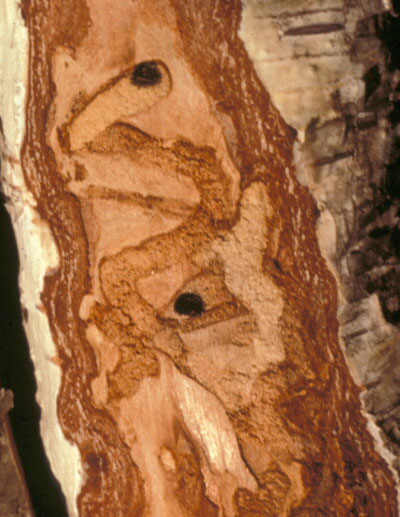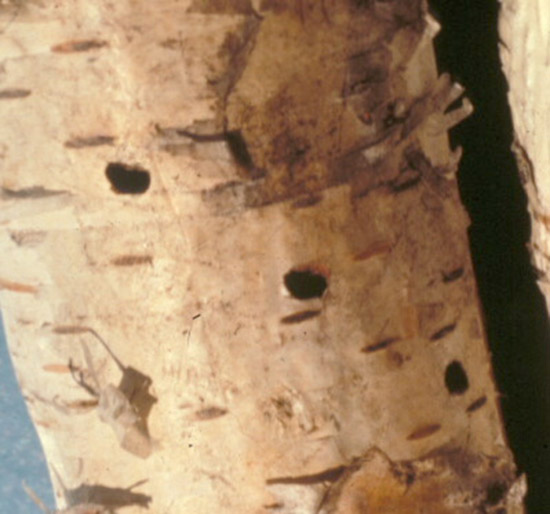Issue 4, May 18, 2015
Bronze Birch Borer
Bronze birch borer is a native species in the same genus as emerald ash borer and attacks the tree in a similar manner, except that it attacks birches instead of ash. Bronze birch borer attacks mostly nonnative, white-barked birches as their growth starts to slow down, typically when the trees reach 10 or more years old. It attacks younger trees that are mechanically damaged or planted in poor sites. Native white-barked birches are attacked much later in life, as they decline into old age. Whitespire, a variety of an Asian species, is resistant to the borer, but many other Asian and European varieties and species are very susceptible to attack. The North American native river birches are also resistant to attack, and Heritage is a variety of river birch commonly planted because of its light-colored bark.
Adult bronze birch borer beetles lay eggs under loose bark and in bark cracks near the top of the tree. The hatching larvae tunnel through the cambium. If the tunneling circles the stem, this girdling kills the stem beyond that point. Leaves turn brown and fall off. Early attack is recognizable as dead, leafless branches at the top of the tree. In subsequent years, the beetles attack lower and lower on the tree until the entire tree dies.

Bronze birch borer tunneling damage.
Bronze birch borer larvae are elongate, white, and flattened, with obvious beadlike segments. Fully grown larvae are about 1 inch long. The larvae feed through the summer, overwinter as larvae, and pupate in the cambium area in spring. Although the life cycle can be completed in 1 year, a 2-year life cycle is more common.
Adult beetles emerge through D-shaped holes during vanhoutte spirea bloom in mid spring. Cross-sections of adult beetles are flattened dorsallly and rounded ventrally, that is, D-shaped. They are about 1/2 inch long and appear bullet-shaped from above, being quadrate in front and tapered posteriorly. As the name indicates, they are bronze in direct sunlight but appear blackish in indirect light. The adult beetles feed on the leaves of alder, poplar, and birch, but this feeding is not severe.

Bronze birch borer emergence holes.
It is now time to treat for bronze birch borer throughout the state. The ideal application time for systemic insecticide application is 30 days before beetle emergence, but acceptable control should still be possible even in southern Illinois where the beetles will have already emerged. Effective control includes emamectin benzoate (Tree-age) as a trunk injection, imidacloprid (Merit, IMA-jet, Imicide, Xytect) as a trunk injection, soil injection, or soil drench, and dinotefuran (Safari) as a trunk spray, soil injection, or soil drench. (Phil Nixon)
Author:
Phil Nixon